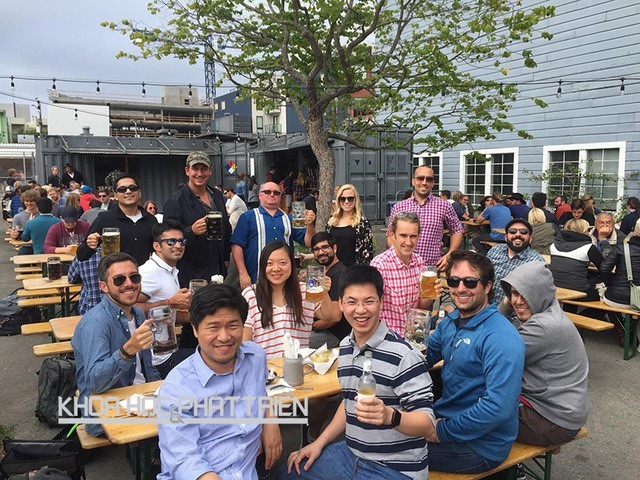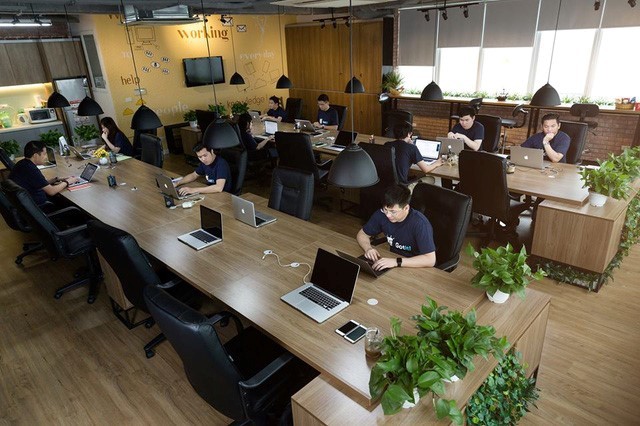(VOVWORLD) - Striving to realize the "Make in Vietnam" strategy, Querychat, a service aimed at cloud-based data stores, has attracted a lot of attention in the information technology field. In the three years since its launch in 2019, Querychat has adapt nimbly to new developments.
Querychat, the first on-demand cloud service for analytics, deploys a scalable and elastic pool of vetted analytics experts to add business intelligence (BI) capacity with usage-based pricing, and automatically delivers deep learning training data into a natural language processing (NLP) AI system. BI teams can now tap thousands of Got It experts around the globe to quickly handle requests for queries and dashboards while labelling user questions without compromising data privacy. The birth of Querychat broke the limitations of automated Q&A based on keyword searches.
 Got It team in America. (Photo: Science and Development) Got It team in America. (Photo: Science and Development) |
Got It has developed and improved a lot of Querychat products. Le Anh Dung, who is in charge of Got It AI Vietnam (one of the two development branches of Got It), said: “We saw that there was another segment of the market that we could develop, based on the knowledge and technologies we learned in building Querychat. That's Conversation AI. This is a product that helps all companies quickly automate their customer care work. For example, in an e-commerce company, most of the customer service team's job is to answer questions about orders, so why not automate such repetitive work. And up to now, Conversation AI has helped automate about 90% of the work of the customer service team.”
According to Dung, Got It works well with the English language. It is being promoted by the company, and the company is looking for customers in the US market. Conversation AI has many big customers, including popular technology companies. Mr Dung said: “Our target is the global market and, of course, our products will have to be available in all different languages. However, technology related to Chatbot (a program combined with artificial intelligence that interacts with people) is now only in English. A start-up that wants to become a global company must first prove its position in the US market. That’s the reason we focus all our energy and resources on conquering the US market, and when our position is secire, we will expand to other markets.”
 Head office Hanoi. (Photo: genk.vn) Head office Hanoi. (Photo: genk.vn) |
Got It AI Vietnam, if it succeeds in the US market, can become a global company. Dung said: “I highly appreciate the prospects of Got It AI in the US market because there is currently no similar product in the world to the one we are trying to build. There are many companies in the world that provide chatbot services, but to apply that chatbot to a specific company requires a lot of time and effort. However, with Conversation AI of Got It, the company only needs to provide us with the conversation history between the customer and the customer care department, then our system will automatically filter and select the key information. And after just a few minutes, we can have an input data set to train Chatbot. Then just one click and the company has a chatbot that can answer most of the customer's questions.”
Got It's Conversation AI automates the customer care process, but it hopes to go even further. Mr Dung said: “We want to turn Conversation AI into a system that can answer users in any field. We want the Chatbot to understand the content of the question and make its own judgments. For example, users can ask what the Chatbot thinks about a book. The most important thing to achieve our goal is to have the right team. We are trying to recruit the best students from the top universities in Vietnam. We also attract a lot of talent from other technology companies around the world.”
After Querychat, with a product development team mainly of Vietnamese engineers, Conversation AI of Got It AI Vietnam is the next testament to the efforts of a Vietnamese startup to realize the dream of "Make in Vietnam”, an important strategy for creative content made in Vietnam, designed in Vietnam, and manufactured in Vietnam. Mr Dung said: “From the perspective of a person working in the technology field, I’m happy to see that the government has the right strategies when pushing technology companies and corporations in the direction of Make in Vietnam. We are doing our best to support that strategy. Make in Vietnam has great potential. With a huge IT force, we have to think about using our own products and focus on research and development to know what to do to build, perfect, and sell those products.”